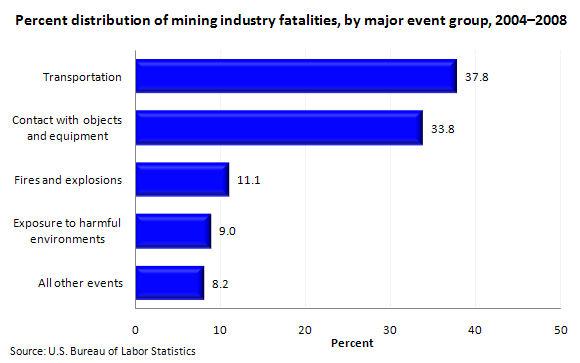August 1, 2011 (The Editor’s Desk is updated each business day.)
Workplace fatalities in mining, 2004–2008
Over the 5-year period from January 1, 2004, to December 31, 2008, more than 90 percent of the workplace fatalities in the mining industry resulted from four kinds of events: transportation accidents, contact with objects and equipment, fires and explosions, and exposure to harmful environments.

[Chart data]
Transportation accidents accounted for the largest proportion of mining fatalities (about 38 percent) over the 2004–2008 period, followed closely by contact with objects and equipment (34 percent). The other two event categories—fires and explosions and exposure to harmful environments—together made up about a fifth of the fatalities in the industry.
The mining, quarrying, and oil and gas extraction sector is composed of employers in oil and gas extraction, coal mining, metal ore mining, nonmetallic mineral mining and quarrying, other types of mining, and mining support activities. It has been identified as one of the more hazardous industries in terms of occupational fatality rates.
These data are from the Injuries, Illnesses, and Fatalities program. To learn more, see "Transportation Fatalities in the Mining Sector: 2004–2008" in the July 2011 issue of Compensation and Working Conditions Online.
Related TED articles
Industry studies |
Occupational safety and health
Of interest
Spotlight on Statistics: National Hispanic Heritage Month
In this Spotlight, we take a look at the Hispanic labor force—including labor force participation, employment and unemployment, educational attainment, geographic location, country of birth, earnings, consumer expenditures, time use, workplace injuries, and employment projections.
.
Read more »
